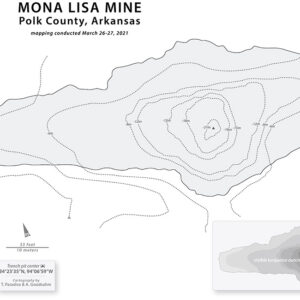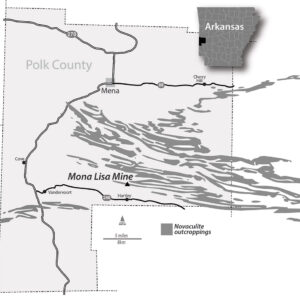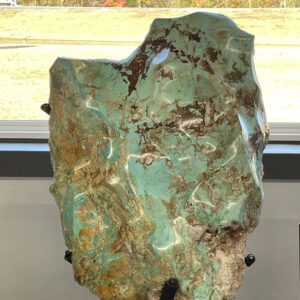calsfoundation@cals.org
Mona Lisa Mine (Polk County)
aka: Porter Ridge Mine
aka: McBride Mine
aka: Blue Bird Mine
aka: Newton Mine
The Mona Lisa Mine, located in Polk County on the ridge of Little Porter Mountain north of Gillham (Sevier County), was first opened in 1958 for the purpose of mining phosphate for agricultural fertilizers. Phosphate mining in other counties decreased the demand for mining from the Mona Lisa Mine, however, resulting in its closure sometime prior to 1963. In 1974, the property was discovered to contain turquoise. This discovery was made by property owner Jack McBride of Denver, Colorado (for this reason, it is sometimes referred to as the McBride Mine). Initial reports estimate that turquoise production of the McBride Mine totaled around 600 pounds. Much of the output of the McBride mine was dyed, stabilized, and compressed into cylinders for shipment to China to be used for carving stock. Some treated and untreated gem material was marketed in New Mexico and Arizona.
The mine was reopened in 1978 and operated intermittently until 1986, mining turquoise under the direction of Jack Wigley, a construction contractor from Dallas, Texas. By this time, the mine was referred to as the Mona Lisa Mine, for reasons that remain unknown. An estimated 25,000 to 30,000 pounds of turquoise were mined during his operation, most of which was lost due to inexperience and unfamiliarity with stabilization processes. Operations closed in 1986, and the mine was reclaimed by the Bureau of Land Management (BLM) between 1989 and 1991.
In 2017, James Zigras—founder and owner of Avant Mining LLC—purchased a placer claim for the Mona Lisa Mine from the BLM. The following year, Avant Mining produced over 1,000 pounds of turquoise in under one week from its test trench. The mine operated inconsistently—due to COVID-19, weather, or equipment issues—though limited production resumed in early 2022.
While the Mona Lisa Mine is not widely known, it did produce the largest known American turquoise nugget on record. The initial total weight was estimated to be around 500 pounds before a large chunk broke off during extraction. Before being cut and polished, the boulder weighed approximately 380 pounds; the final product weighed in at 245 pounds. While the nugget was mined by Wigley in 1982, it was not polished until 2018, after it was purchased by Zigras; the same year, Avant Mining presented it at the Tucson Gem and Mineral Show in Tucson, Arizona. It was then put on display at the Avant Mining Fisher Mountain Rock Shop in Mount Ida (Montgomery County), which is also owned by Zigras.
Turquoise mined from this site differs in color and structure from the turquoise mined in western states such as Arizona, Nevada, and New Mexico. Arkansas Turquoise often has bits of green and beige in it, and, in many cases, must be stabilized with an epoxy resin before being cut and polished for jewelry. It is also free from the spiderweb patterns that frequently appear in the Southwestern variety. Geologists attribute these characteristics to the differences in climate, topography, and surface exposure, and to the presence of other minerals, including copper, iron, and lead.
Individual types of turquoise are usually named according to their source. All turquoise mined from this specific location is called Mona Lisa Turquoise, though Arkansas Turquoise is the preferred formal usage for any turquoise originating from Arkansas. Mona Lisa Turquoise is more affordable than its southwestern counterparts, largely because of the doubt that surrounds the presence of true turquoise outside of the American Southwest. A 2020 study found that samples from the Mona Lisa Mine qualify as true turquoise, but with a slightly more copper-deficient concentration than ideal turquoise, which contains higher concentrations of copper and no iron. However, the affordability of Arkansas Turquoise may change with the wider publicity regarding mining activities, production, and geological analyses.
For additional information:
Archuleta, Jennifer-Lynn, and Nathan Renfro. “Turquoise from Western Arkansas.” Gems & Gemology 54, no. 1 (Spring 2018). Online at https://www.gia.edu/gems-gemology/spring-2018-gemnews-turquoise-from-western-arkansas https://www.gia.edu/gems-gemology/spring-2018-gemnews-turquoise-from-western-arkansas(accessed March 5, 2024).
Goodsuhm, Alexander Arai. “A Geochemical and Mineralogical Evaluation of the Mona Lisa Turquoise Mine, Polk County, Arkansas.” MS thesis, University of Arkansas, 2022. Online at https://scholarworks.uark.edu/etd/4420/ (accessed March 5, 2024).
Laney, Stephen E. “Turquoise in the Ouachita Mountains: In Polk County, Arkansas.” Mineral News 30, no. 9 (September 2020): 1, 6, 9–11, 13–14.
Wigley, Jack. “ARKANSAS TURQUOISE: How I Became a Gem Miner.” Rock & Gem 36, no. 4 (April 2006): 28–30.
Mysti L. Gates
University of Arkansas Rich Mountain
 Divergent Prosperity and the Arc of Reform, 1968–2022
Divergent Prosperity and the Arc of Reform, 1968–2022 Geography and Geology
Geography and Geology Mona Lisa Mine Isohypsometry
Mona Lisa Mine Isohypsometry  Novaculite Outcroppings
Novaculite Outcroppings  Turquoise Nugget
Turquoise Nugget 




Comments
No comments on this entry yet.